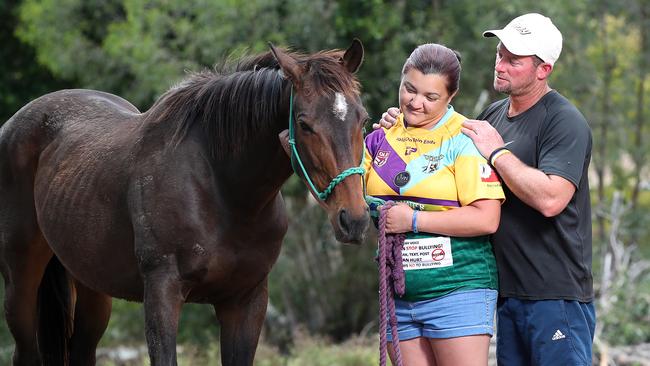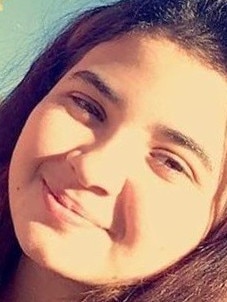Mum vows to educate others about the suicide signs she missed in her own teenage daughter
Chloe Walklate took her own life at just 13 years old. Her mum, Sam, has vowed to raise awareness about suicide to help other families.
QLD News
Don't miss out on the headlines from QLD News. Followed categories will be added to My News.
A SOFT drink can still sits on a window ledge in Chloe Walklate’s bedroom, more than two years after the 13-year-old took her own life.
In her mind, Chloe’s mum, Sam, can still see her daughter, soft drink in hand, looking out her bedroom window and smiling on the last night of her life — September 12, 2017.
“She put the can on the windowsill,” Mrs Walklate said. “That still sits there. Every time I look at that can of soft drink from outside the house, I still have that picture of her smiling inside my head. I don’t want to move it.”
RESEARCHERS WORKING ON OBJECTIVE TEST FOR PTSD

Horse posters decorate Chloe’s bedroom walls, her clothes hang in the wardrobe and grooming equipment for her horse, Ace, is still there, too. Her purse is where she left it, money inside.
More than two years after her suicide, Chloe’s bedroom remains largely untouched since that day — except for a fruitless search by her father, Kyle, for a note, an explanation as to why.
Why would a beautiful girl with a loving family, and plans to work with animals one day, perhaps as a veterinarian or a vet nurse, want to take her own life?
Mrs Walklate found her daughter had died by suicide when she arrived home early from work on September 13, 2017.
“Chloe had so much to live for. It hurts that we couldn’t save her, that we couldn’t see the signs,” she said.
The Year 7 student at Windaroo Valley State High School, south of Brisbane, was one of 24 Queenslanders under 18 years of age who took their own lives in 2017, anonymous faces of the leading non-natural cause of death in children.
Four months after Chloe died, Amy “Dolly” Everett’s decision to take her own life on a remote cattle property in the Northern Territory put the national spotlight on youth suicide.
In 2017, 804 Queenslanders ended their own lives — more than three times the road toll of 247 deaths that year.
Last year, 786 Queenslanders died by their own hands — a two per cent drop after a decade of rising suicide rates. By comparison, in 2008, 553 Queenslanders ended their own lives.
Queensland Mental Health Commissioner Ivan Frkovic said the recently released 10-year Queensland Suicide Prevention Plan set a “bold target” of trying to halve the state’s suicide rate by 2026.

Queensland has a lot of work to do. The year Chloe died, the state recorded a suicide rate of 16.3 deaths per 100,000 people, compared to the national average of 12.6 per 100,000.
“One suicide is too many,” Mr Frkovic said. “We all have a role in suicide prevention. We don’t have to be clinicians. It’s about being there to support someone and not fearing to engage in a discussion where a young person may disclose that they don’t see themselves here tomorrow … then helping that person access the services they need.”
Mr Frkovic, who was unable to comment on the circumstances surrounding Chloe’s death, said the Queensland Suicide Prevention Plan “is really about how we work better together to provide a safety net for people so they don’t fall through the gaps”.
The Walklates knew Chloe was troubled, but they were oblivious to the severity of their daughters’ problems, putting them down to “a teenager going through hormone changes”.
She was regularly skipping school and the once “bright student” no longer seemed interested in the classroom.
“She couldn’t concentrate,” Mrs Walklate recalled. “She was trying to read a book for an assignment and she said: ‘Mum, I can’t read it’.
“I’m like ‘What do you mean you can’t read it? You can read.’ But that’s a sign of depression, of mental illness. She couldn’t concentrate. She was falling behind. She wasn’t doing her schoolwork.
“I was naive to the signs. She was the kid that made everyone laugh and made everyone happy. Little did we know she was so hurt. That’s what they say, the people who hurt the most try to make everyone else so happy. That’s what she would do. She’d goof around, play jokes on people.
“The night before, she was riding her horse and then she was on the phone to an old school friend, laughing and joking. I don’t know what happened between then and the next day.”
The Walklates had no idea until after Chloe’s passing that she had spoken to friends and at least one adult in her life of having suicidal thoughts, including about 48 hours before she took her own life.

Children’s Health Queensland suicide prevention co-ordinator Rachael McIntosh said a young person having thoughts of suicide “should never be kept a secret”.
“Keeping the secret actually prevents that young person from getting the help that they so desperately need, even if they say they don’t want help,” Mrs McIntosh said.
The psychologist said if parents, carers, friends or family members had concerns about a young person they should “ask them how they’re going and specifically ask the question directly: ‘Are you having thoughts of suicide’?”
“There’s a common misconception that talking about suicide potentially will make it worse or put the idea in their head,” she said.
“That’s actually one of the most dangerous myths about suicide because it prevents help seeking.
“Actually talking about suicide increases the likelihood that they are going to engage in helpful services and often young people are relieved when somebody asks them directly.
“The other thing that I would say is that if a young person does start to tell their story, to hear them out fully, without judgment. Let them know that you’re there and help them link in with a guidance officer, general practitioner, Headspace, child and youth mental health service or accessing a help line or chat line.”
After the trauma of Chloe’s suicide, Mrs Walklate is keen to do everything she can to educate parents, teachers, doctors and young people on suicide warning signs, hoping to save other lives.
The bank worker, who also has two sons and a stepdaughter, has undertaken a mental health first-aid program since Chloe’s death so she can raise awareness.
“I made a promise to her when she passed that I will find answers and stop this from happening to others,” Mrs Walklate said, adding she hopes to set up a suicide support group for families in the Logan area, south of Brisbane.
“There’s lots to do. So many kids out there need help.”
October is National Mental Health Awareness Month.
For help
Kids Helpline: 1800 55 1800, kidshelpline.com.au
Lifeline: 13 11 14
Suicide Call Back Service: 1300 659 467
Youth suicide: Know the Signs
•Dramatic changes in mood, from what they’re normally like, even if they’re suddenly happy.
•Giving away possessions.
•Talking about death or expressing feelings of worthlessness or hopelessness, feeling like they’re alone or a burden on their family.
•Giving hints that they’re thinking about suicide, even as a joke.
•A sudden deterioration in schoolwork.
•Increased drug or alcohol use.
•Previous suicide of a friend or family member.


